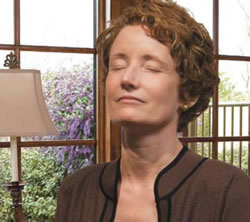Finding the Calm Within
Guided Imagery Offers Comfort, Strength

Dana Muir doesn't sit and wait easily.
After Muir, a professor of business law at the U-M Ross School of Business, was diagnosed with breast cancer, it was rough to wait to find out how far her cancer had progressed. That's when she found out about the Rogel Cancer Center's Guided Imagery Program, led by Claire Casselman, a clinical social worker in the Complementary Therapies Program.
"It was something that enabled me to think of something positive while there was so much ambiguity," Muir said. "I think it's quite typical to feel like you have little in the way of control or power. Claire worked with me to maintain a positive attitude with imagery that didn't pretend the problem didn't exist."
Guided Imagery is a technique that combines visualization and relaxation. Numerous studies have shown it to be beneficial:
- It lowers blood pressure,
- decreases stress hormones
- helps with chronic pain
- enhances sleep
- lessens side effects
- boosts the immune system and
- improves surgical recovery.
Casselman, whose work in this area is funded by Rogel Cancer Center donors, consults with patients to develop individualized programs. She talks with them to understand what types of imagery they find comforting or helpful -- whether it's envisioning the soothing presence of a beloved family member or conjuring cellular armies to do battle with their cancer.
Regardless of what type of imagery is employed, the sessions start with relaxation. Casselman asks patients to focus on breathing or to tense and relax different muscles. She encourages them not to stop thinking, but to "file" worries away: to watch them, rather than engage them.
"It's about focusing on something different," Casselman said. "It's about telling the left side of your brain, 'you've done a good job in helping me to be safe, but you need to take a back seat right now.'"
When quite stressed, the left side of the brain, where logic and analytical thought is processed, signals the release of stress hormones like adrenaline and cortisol -- hormones that aid the bodys "fight-or-flight" instincts. Guided Imagery helps to activate the right side of the brain, which gives rise to creativity and signals the release of the body's biochemicals that aid in relaxation and healing. Because about a third of people aren't visually oriented, Casselman said, she also incorporates the other senses into the sessions.
Although Guided Imagery is similar to meditation, people often have misconceptions, Casselman said. There's more discussion than some expect. When working with patients who like to be active, Casselman develops programs that involve imagining how it feels when muscles are firing during a bike ride or a long walk.
The goal, no matter what people think about, is to gain a sense of calm that lingers long after the session is over.
"It helps you feel more in control," Casselman said. "Is it going to cure cancer? Maybe not. But will it help you leverage opportunities? Absolutely."
Continue reading Spring, 2007 issue of Thrive
